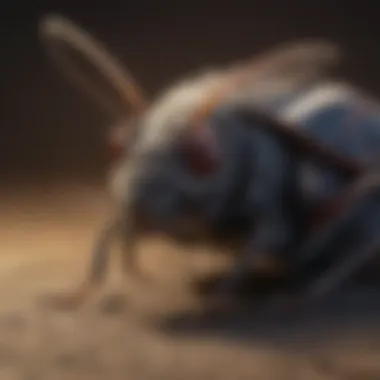Understanding Consumer Choices in Pest Control


Intro
By focusing on pest identification, prevention strategies, and treatment options, individuals will acquire knowledge that is crucial for making informed decisions. This information serves not just homeowners, but also pest control professionals seeking to better engage with their clients.
Pest Identification
To effectively deal with pest issues, it is essential to understand what pests may threaten one’s living space. Different pests present varying challenges and may require distinct approaches to control and manage.
Detailed descriptions of common pests
Ants: These social insects are often found in kitchens and pantries, attracted to food sources. Common species include the carpenter ant and the odorous house ant.
Cockroaches: Known for their resilience, cockroaches can thrive in unsanitary conditions. German and American cockroaches are the most recognized species.
Rodents: Mice and rats can invade homes, causing damage and health risks. The house mouse and the Norway rat are two prevalent varieties.
Signs and symptoms of infestations
Identifying an infestation early can make a significant difference in managing pest problems effectively.
- Droppings: Noticing small droppings around the house is often a sign of pests, particularly rodents.
- Nesting materials: Finding shredded paper or insulation may indicate the presence of rodents.
- Visible pests: Spotting ants in a line or cockroaches scuttling during the day suggests a serious infestation.
Prevention Strategies
The best pest control method often lies in effective prevention. By implementing a few strategies, homeowners can significantly reduce the likelihood of pests entering their homes.
Home maintenance tips for pest prevention
Regular upkeep of living areas is vital. Here are some pointers:
- Seal entry points: Inspect and seal gaps and cracks around windows, doors, and foundations.
- Store food properly: Keep food tightly sealed and promptly clean spills to avoid attracting pests.
- Maintain landscaping: Trim back plants that touch the house and ensure gutters are clean to minimize pest access.
Natural deterrents and barriers
Using natural methods can also aid in keeping pests at bay:
- Essential oils: Peppermint oil, for instance, can deter mice when applied on entry points.
- Diatomaceous earth: This powder can be sprinkled around entry points to create a barrier against ants and cockroaches.
Treatment Options
If prevention fails, one must explore treatment options that suit their needs and preferences. Options vary widely in terms of effectiveness and safety.
Overview of chemical vs. natural treatments
- Chemical treatments: Products like Raid or Ortho can be effective but often raise concerns about safety, especially in homes with children or pets.
- Natural treatments: Solutions such as vinegar or baking soda present lower risks and can be effective for minor infestations.
Step-by-step guides for DIY treatments
For those interested in managing pest problems independently, here are simple steps to follow:
- Identify the pest: Confirm the type of pest you are dealing with.
- Choose a treatment: Select chemical or natural solutions based on your comfort level and needs.
- Apply treatment as directed: Follow instructions provided with the product to ensure safety and effectiveness.
- Monitor results: Observe the treated area and assess if additional measures are needed.
"Understanding pests and the options available helps homeowners make better decisions for a pest-free environment."
In the next sections, we will expand further on these topics and synthesize information useful for various stakeholders in pest management.
The Basics of Consumer Choice in Pest Control
Understanding consumer choice in pest control is crucial for homeowners and professionals alike. The decisions made in this area can significantly impact both the effectiveness of treatment and the long-term management of pest issues. The pest control market is diverse, encompassing a variety of methods and products. By gaining insights into consumer behavior and preferences, the industry can enhance the value it offers to its clientele.
Consumer choice in pest control solutions is influenced by multiple factors. The importance of this section lies in its ability to break down complex considerations into manageable elements that consumers can use in making informed choices.
Defining Consumer Choice
Consumer choice refers to the decisions that individuals make regarding the products and services they select to address specific needs. In the context of pest control, this encompasses everything from selecting a particular treatment method to choosing between professional services or DIY solutions. Understanding what drives these choices helps ensure that consumers can effectively address pest problems while aligning with their values and priorities.
Factors Influencing Pest Control Decisions


Several core factors shape how consumers approach pest control. Each of these influences contributes to the overall decision-making process, establishing preferences based on individual circumstances.
Cost considerations
Cost plays a significant role in consumer decisions about pest control. Homeowners often weigh the price of treatments against their budgets. Understanding the financial implications is essential for making choices. Many customers seek affordable options that provide value without compromising on effectiveness.
A key characteristic of cost considerations is the desire to achieve optimal results at minimal expense. Consumers may compare various products and services based on pricing structures. This can involve looking at both upfront costs and potential long-term savings through prevention measures.
The unique feature of cost considerations is how it influences short-term and long-term decision-making. A cheaper treatment option may be appealing initially but could lead to higher expenditure down the line if it fails to address the problem effectively.
Efficacy of treatments
Efficacy is another vital aspect consumers consider. This relates to how effective a pest control solution is at eliminating or managing pests. Homeowners want assurance that the method they choose will yield tangible results. This factor is especially important for those who have experienced persistent pest issues or health concerns related to infestations.
A key characteristic of efficacy is that it directly correlates with consumer satisfaction. When treatments work as promised, customers are more likely to recommend them to others. Conversely, a lack of effectiveness can lead to frustration and mistrust.
Efficacy has a unique feature in that it often involves consumers gathering outside opinions, including reviews and testimonials, before making a choice. This creates a situation where word-of-mouth marketing becomes a critical component in a product's or service's success.
Environmental impact
Consumers today are increasingly aware of the environmental implications of their choices. This includes being conscious of the chemicals used in pest control and their potential harm to non-target organisms and ecosystems. The move toward more environmentally friendly options is driven by a growing desire for sustainability.
The key characteristic of environmental impact considerations is the prioritization of ecological health alongside effective pest management. Homeowners may opt for solutions that promise to be less harmful to the environment, even if they come at a slightly higher cost.
The unique feature here is that consumer awareness of environmental factors can influence market trends. As more consumers demand eco-friendly pest control options, companies may need to adapt by developing greener products and methods.
By examining these contributing factors, consumers can make more informed decisions regarding pest control solutions that not only address their immediate needs but also align with their broader values and considerations.
Understanding Pest Control Options
The area of pest control options is crucial for homeowners who need effective solutions to manage unwanted pests. Understanding the different methods allows for informed decisions based on effectiveness, safety, and environmental impact. This section breaks down chemical and natural methods, providing knowledge that can affect consumer choices.
Chemical Pest Control Methods
Chemical pest control remains a major approach for many consumers. This method generally involves using synthetic or natural chemicals to eradicate pests. Understanding this method involves several key aspects that inform choices.
Types of chemical products
When exploring chemical pest control products, the variety available is significant. Brands like Ortho Home Defense or Raid offer specific formulations targeting various pests. These products often contain insecticides, herbicides, or fungicides.
Typically, the main characteristic of these products is their quick action. Users appreciate fast results when dealing with infestations. What makes them popular is their wide availability in stores and online. However, these products may come with potential downsides, such as toxicity to non-target organisms including pets or beneficial insects.
Regulatory aspects
Regulation of chemical pest control is essential for safety. Agencies like the Environmental Protection Agency (EPA) oversee the approval and use of these chemicals. Understanding these regulations ensures consumers use products that meet safety standards.
A key characteristic of these regulations is that they require rigorous testing before products reach the market. This is beneficial as it helps prevent harmful chemicals from being accessible without oversight. However, the complexity of regulations can sometimes confuse consumers, who may not fully grasp which products are appropriate and safe for home use.
Safety considerations
Safety is a primary concern when it comes to chemical pest control. Many homeowners look for products that are explicitly marked as safe for indoor use. This concern drives decision-making around pest control options.
A distinctive feature of safety in these products is their label instructions, which include things like personal protective equipment or ventilation requirements. Such instructions are critical to successful and safe utilization of the product. Unfortunately, not all consumers read the labels thoroughly, which can lead to misuse.
Natural Pest Control Solutions
As consumers increasingly focus on health and environmental factors, natural pest control solutions have gained popularity. This trend is significant, as it reflects growing concern over chemical exposure and sustainability.
Effectiveness of natural methods
Natural pest control methods often utilize substances derived from plants or naturally occurring processes. Examples include diatomaceous earth and essential oils like peppermint.
These methods' key characteristic is their reduced toxicity compared to chemical pesticides, making them appealing for households with children or pets. Some consumers find these methods less effective for severe infestations, which can limit their appeal. However, they are often lauded for their environmental benefits.
Popular natural remedies
Several natural remedies are widely acknowledged, such as vinegar and baking soda to deter pests or essential oils like cinnamon to repel insects. These products are commonly found in many household kitchens, making them easily accessible.
The advantage of these remedies is their low cost and ease of use. However, they may not always provide the immediate results that homeowners expect when dealing with a serious pest problem.


Limitations and challenges
Natural pest control methods do come with limitations. For instance, they may require more frequent application compared to chemical alternatives. Furthermore, effectiveness can vary widely depending on the type of pest and the specific method used.
This unpredictability may deter some consumers, who prefer solutions that provide guaranteed results in a shorter timeframe. While natural methods are generally safer, the time and labor involved in finding and applying them can be a drawback for many.
Consumer Knowledge and Awareness
Consumer knowledge and awareness play a crucial role in the decision-making process for pest control solutions. Homeowners must understand the various options available, the potential impacts of different treatments, and the significance of safety. When consumers are informed, they can make choices that align with their values, be it efficacy, environmental concerns, or health effects.
Informed consumers are more likely to select responsible pest control methods. They can evaluate products critically and discard myths that may lead to poor choices. The benefits of increased awareness include greater satisfaction with service, enhanced pest management, and reduced risks related to ineffective or harmful treatments.
Education and Resources
Effective communication from pest control companies
Effective communication from pest control companies is pivotal. Clear interaction informs consumers about the nature of the pest problems, the treatments available, and their implications. This communication should not only present facts but also be responsive to customer questions and concerns.
An essential characteristic of effective communication is transparency. This transparency helps to build trust between companies and their clients. When consumers can see the rationale behind suggested treatments, they are more likely to choose those services based on a clear understanding.
Despite its advantages, there can be drawbacks if the companies do not provide adequate details or use jargon that confuses customers. This may lead to decision-making based on incomplete or misinterpreted data.
The role of online resources
The role of online resources in pest control knowledge cannot be underestimated. The internet serves as a vast repository of information for consumers seeking pest control solutions. Websites, forums, and social media platforms allow individuals to share experiences, advice, and product reviews, shaping their choices.
A key feature of these resources is accessibility. Consumers can easily find a variety of opinions and solutions at their fingertips. This can empower individuals to make informed choices before engaging pest control services.
However, the risk lies in the quality of information available online. Misinformation can spread rapidly, leading potential users to choose ineffective or unsafe methods if not careful.
Identifying credible information sources
Identifying credible information sources is vital for discerning homeowners. Accessing accurate information helps ensure that decisions regarding pest control are based on sound advice rather than myth.
A fundamental attribute of credible sources is their reliance on research or expert testimonials. Information from recognized organizations or institutions often carries more weight than anonymous user reviews.
The unique feature of this process is the need for consumers to discern the reliability of the source. This can become challenging when faced with mass amount of content online. Consumers must learn to assess sources critically to avoid falling for misleading narratives regarding pest control practices.
Debunking Common Pest Control Myths
Many myths still persist about pest control. The truth is often far from what is popularly believed. For instance, some homeowners think that all pest control methods are harmful, but this is not the case. Many solutions are indeed safe when used properly.
Another myth is that pests can be completely eradicated with a single treatment. In truth, effective pest management often requires ongoing strategies which incorporate prevention.
Debunking these myths is important not only for consumer safety but also for promoting an understanding of effective pest management practices.
The Role of Consumer Reviews
Consumer reviews have become an essential element in shaping decisions for pest control solutions. With the internet facilitating easy access to information, potential customers turn to reviews for guidance. This reliance on customer feedback helps create a more transparent market environment, where service providers are held accountable for their offerings.
The Influence of Customer Feedback
Customer feedback plays a pivotal role in influencing consumer choices. When individuals look for pest control services, they often read reviews on platforms such as Facebook, Reddit, or dedicated pest control websites. Positive reviews can significantly enhance a service's appeal, whereas negative feedback can deter potential customers.
Reviews serve as a form of social proof, indicating whether a service has been effective and satisfactory for others. This information is invaluable for consumers who may feel overwhelmed with choices in the pest control sector. Additionally, constructive criticism can motivate companies to improve their services, ultimately benefiting the consumer.
Evaluating Pest Control Services
When evaluating pest control services, it is crucial to consider various criteria.
Criteria for assessment
Criteria for assessment can vary, but key factors often include effectiveness, safety, and customer service. Each of these aspects contributes to making informed decisions.
One key characteristic of efficacy is tracking the success rate of specific treatments. Homeowners should look for data or testimonials regarding how well a service has dealt with particular pest problems. This can involve comparing results from different providers in similar situations.
A unique feature of safety standards in pest control includes adherence to regulatory guidelines. Companies that prioritize safety will often showcase their compliance with local and national standards. This can be a strong indicator of their commitment to providing a service that protects both the consumer and the environment.
Furthermore, customer service can dramatically influence overall satisfaction. Prompt and informative communication can lead to positive experiences. Conversely, poor customer service can overshadow even the most effective pest control solutions, leading to dissatisfaction.


The impact of reputation
The impact of reputation extends beyond individual reviews. A pest control company's overall standing in the community can significantly affect consumer choices. A positive reputation signals reliability and quality, factors crucial for homeowners seeking effective solutions.
Reputation is built not only on reviews but also on how a company communicates with its clients. For instance, companies that respond proactively to negative feedback often show that they value customer satisfaction. This can enhance their standing in the market.
A unique feature of reputation is its ability to act as a an instant filter for consumers. When faced with multiple options, many people gravitate toward well-reviewed companies. However, it is important to cautiously assess the feedback as reputation alone doesn’t guarantee an exceptional experience.
Best Practices for Homeowners
Navigating the pest control landscape can be overwhelming for many homeowners. Adopting best practices enables effective management of pest issues, ensuring a safer and healthier living environment. This section will discuss critical practices that homeowners should embrace, which can eliminate pests efficiently and prevent future infestations. Recognizing pests correctly and implementing preventive measures can save time, money, and reduce stress associated with pest problems.
Identifying Pests Effectively
Common indicators of infestation
Homeowners must be vigilant in spotting signs of pest infestations. These indicators serve as early warnings, allowing for prompt action. Common signs may include droppings, damaged food sources, and unusual noises during the night. For example, the presence of tiny feces or chewed items commonly indicates rodents. Identifying these signs can help determine the type of pest and the severity of the problem, which is essential for targeted interventions.
The key characteristic of these indicators is their visibility; when homeowners notice them, they signal that intervention is necessary. This understanding contributes to timely pest control, minimizing damage and health risks.
Unique features of these indicators include their specificity. For instance, different pests leave distinct signs. While mouse droppings are small and pellet-shaped, cockroach droppings appear as dark specks. Recognizing these differences can guide homeowners in choosing the best treatment methods.
Tools for pest identification
Various tools can assist homeowners in accurately identifying pest species. These tools include magnifying glasses, inspection mirrors, and smartphone apps designed specifically for pest identification. Using these resources can increase awareness of the pest issue and facilitate proper management techniques.
The primary characteristic of these tools is their accessibility. Many homeowners already possess smartphones, making apps a convenient option for immediate assistance. Additionally, household items like magnifying glasses can enhance visibility of small indicators. These tools empower homeowners to take charge of pest problems with confidence.
A unique feature of these identification tools is their educational aspect. Many apps offer information about the pest’s life cycle and control measures. This knowledge is beneficial for preventing future infestations but can sometimes lead to misinformation if the sources are not credible. Homeowners should ensure they utilize trusted resources, allowing for effective pest management.
Regular Prevention Strategies
Routine inspections
Conducting routine inspections is essential in maintaining a pest-free home. Regular checks in attics, basements, and around food storage areas can catch potential infestations early. Homeowners can systematically assess these locations, examining for signs such as nests, droppings, or damage to structures.
The key characteristic of routine inspections is their proactive nature. By regularly checking for signs of an infestation, homeowners can act before the situation escalates, preventing costly damage and health risks. Establishing a regular inspection schedule can lead to long-term success in pest management.
A unique feature of these inspections is their adaptability. Homeowners can tailor inspection schedules according to seasons or previous infestation experiences. For example, after a particularly warm summer, more regular inspections in the fall are advisable, as pests often seek shelter indoors.
Creating barriers against pests
Creating effective barriers against pests is another valuable strategy for homeowners. This includes sealing cracks in walls, screening windows, and ensuring that doors fit tightly. Physical barriers limit pests' access points to homes, significantly reducing the likelihood of infestations.
The key characteristic of these barriers is their preventative function, acting as the first line of defense against unwanted insects and rodents. Implementing these measures is a cost-effective choice for homeowners, often requiring minimal materials and effort.
A unique feature of physical barriers is their permanence. Once properly installed, they can provide long-term protection, as they do not rely on chemicals or ongoing treatments. However, homeowners must remain vigilant about maintaining these barriers, as wear and environmental conditions can compromise their effectiveness over time.
"Proactive pest management planning through identification, prevention, and routine care ensures that homeowners can maintain a safe living environment."
By integrating these best practices, homeowners can enhance their pest control strategies significantly. The focus should be not only on managing current infestations but also on anticipating and preventing new ones.
Culminations and Future Directions
In this section, we will explore the ramifications of consumer choices in pest control. Understanding these choices is essential for homeowners seeking effective and safe pest management solutions.
The evolution of consumer preferences has transformed over the years. With increasing awareness about environmental issues, consumers are more reluctant to rely solely on chemical solutions. They are considering natural pest control methods more than before. This shift is producing various implications for both consumers and the pest control industry. Consumers desire transparency in product efficacy and safety. They expect pest control providers to adapt to their evolving needs.
"Consumer awareness is driving the change in pest control solutions, compelling companies to innovate their offerings to meet modern expectations."
Life changes, regulations, and advancements in pest management technologies also affect consumer choices. With the growing availability of information online, people can make better-informed decisions. Homeowners now have more access to resources about pest identification and treatment options than previous generations. This trend provides a chance for pest control companies to educate their clientele, further fostering informed choices.
The Evolution of Consumer Choices in Pest Control
Today, many homeowners are more focused on sustainability. As a result, they often prioritize environmentally friendly solutions when they deal with pest problems. This is a marked departure from the traditional reliance on potent chemical treatments. Social media and digital platforms have provided consumers with a voice, amplifying their concerns and experiences.
Furthermore, pest control brands must keep up with these changes. Innovations in natural pest control solutions are emerging frequently. For example, companies are now offering integrated pest management strategies that combine multiple methods for effectiveness. Homeowners feel empowered by these alternatives, gaining confidence in their choices.
Implications for the Pest Control Industry
The shift in consumer preferences carries significant implications. Pest control companies need to adapt to the changing landscape. This means investing in research and development for safer products and methods. They must also enhance communication efforts, ensuring clients and prospects understand the benefits and limitations of various treatments.
Moreover, this transformation presents opportunities for niche markets. Businesses that specialize in natural or eco-friendly pest control can cater to a more targeted audience. As consumers increasingly demand sustainable options, such businesses may thrive.
In summary, the conclusions drawn from this article can guide future actions in the pest control sector. Both consumers and businesses must remain abreast of ongoing changes, fostering a collaborative approach toward effective pest management.



